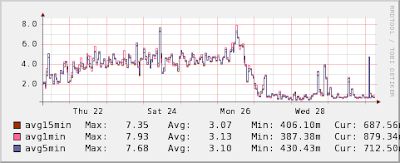I always had this in mind, but until recently had no time to look closely at implementing it. Then I saw a forum post with a sample script for generating the nginx configuration file based on Cpanel account info, and then an onslaught of visitors on a shared Cpanel server I admin slowed it to a crawl, and I was forced to delve into the innards of Cpanel. As a result of this investigation I wrote the "nginx on Cpanel" HOWTO presented below.
Installing Apache module
First of all, when nginx is used as a reverse proxy to Apache, the visitors' IPs received by Apache are wrong - all requests to Apache come from nginx, so the main server IP will be logged.
To make Apache log the real IPs of the visitors instead of the main server IP, a special Apache module (mod_rpaf) is needed.
Download, untar, cd to the newly created directory and run this command as root:
/usr/local/apache/bin/apxs -i -c -n mod_rpaf-2.0.so mod_rpaf-2.0.c
That will install the module into the Apache module directory.
Then go to WHM, Main >> Service Configuration >> Apache Configuration > Include Editor > Pre Main Include and add this section there, replacing LIST_OF_YOUR_IPS with the list of IP addresses managed by Cpanel:
Apache configuration changes
Then we need to move Apache to another port, let's take 81 for example. You can simply edit it in the "Tweak Settings" page in WHM, replacing 0.0.0.0:80 with 0.0.0.0:81 or, doing it command line way, edit /var/cpanel/cpanel.config and change port 80 in apache_port assignment to 81:
apache_port=0.0.0.0:81Run /usr/local/cpanel/whostmgr/bin/whostmgr2 --updatetweaksettings as advised at the top of that file.
Check /usr/local/apache/conf/httpd.conf for any occurences of port 80, and run /scripts/rebuildhttpdconf to make sure httpd.conf is up to date.
It also makes sense to reduce the number of Apache children, as nginx will take care of spoonfeeding the data to the clients connecting via the slow network links, freeing Apache children to do their backend work. Edit /usr/local/apache/conf/httpd.conf and replace prefork.c section with this (note that I used very modest values here, and your mileage may vary):
Run /usr/local/cpanel/bin/apache_conf_distiller --update --main to pick up the changes, and then /scripts/rebuildhttpdconf to make sure your changes are in.
Note that you will need to watch Apache extended server status at the peak load times to have an idea how many Apache children your server needs by default.
You'll also need to update the Apache port in /etc/chkserv.d/httpd and restart chksrvd with /etc/init.d/chksrvd restart
Generating nginx config files
The final step - we have to build the nginx config file based on the domains hosted on your server.
It is done by the simple script which will generate two configuration files for nginx - main one here: /usr/local/nginx/conf/nginx.conf and the include file with all virtual hosts: /usr/local/nginx/conf/vhost.conf
Run /usr/local/nginx/sbin/nginx -t to check the configuration, and then /usr/local/nginx/sbin/nginx to start nginx. You are set!
If you don't care about the bandwidth consumed by the virtual hosts and are willing to lose the correct bandwidth calculation over the increased server performance, you can uncomment the <location> lines below the WARNING comment and watch the server picking up the speed. Beware of the two gotchas here: the sub domains most likely will not work as they have document root pointed to a different place, and as nginx doesn't support .htaccess files for the performance reasons, they won't be obeyed for the file types listed.
Obviously, the config file must be regenerated every time a new domain is added. The deleted and suspended domains should work just fine though.
Conclusion
You may ask, is it really worth the trouble? Here's a graph of the average load on the server where nginx was installed as a reverse proxy for Apache as described in this post, can you guess where the switch to nginx happened?
